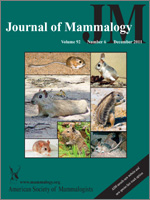Muskrats (Ondatra zibethicus) prey on freshwater mussels, many species of which are threatened or endangered. Muskrat populations have been reduced in some streams where North American river otters (Lontra canadensis) were reintroduced, and it has been hypothesized that otter reintroduction could be used as a tool for conservation of mussels. We used occupancy estimation methods to evaluate the ecological relationship between muskrats and otters by collecting presence–absence data based on field sign found at bridge crossings in eastern and central Kentucky. Mean detection probabilities (ps) and occupancy probabilities (ψ;s) for muskrats were 0.692 (SE = 0.045) and 0.723 (SE = 0.071) and for otters were 0.623 (SE = 0.036) and 0.662 (SE = 0.069), respectively. Otter occupancy was related negatively to distance from release sites, which suggests that the otter population is still expanding its range. A 2-species interaction model indicated that the occupancy by muskrats and river otters was independent, and we conclude that river otter reintroduction would not be an effective strategy for conserving mussels.
How to translate text using browser tools
1 December 2011
Evaluating interactions between river otters and muskrats at bridge crossings in Kentucky
Ryan Williamson,
Joseph D. Clark
ACCESS THE FULL ARTICLE

Journal of Mammalogy
Vol. 92 • No. 6
December 2011
Vol. 92 • No. 6
December 2011
Green River
interaction
interspecific competition
Lontra canadensis
occupancy estimation
Ondatra zibethicus
range expansion




